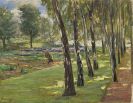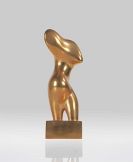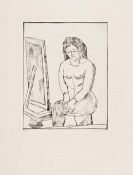
Koloman Moser
Wien
1868 -
1918
Koloman (Kolo) Moser studied design and painting from 1885 until 1892 at the Viennese "Akademie der Bildenden Künste". In 1886 he also studied painting at the "Allgemeine Malerschule". Then he studied graphic design between 1893 and 1895 at the Viennese "Kunstgewerbeschule".
From 1899 Koloman Moser taught there himself, from 1900 as a professor. From 1895 Koloman Moser worked as a freelance graphic designer. Intensely committed to the progressive art trends of his day, Koloman Moser worked in all fields of the decorative and applied arts, designing furniture, glass objects and jewelry as well as leather goods, textiles, book bindings and even toys.
Alongside Josef Hoffmann, Otto Wagner, Adolf Loos, Joseph Maria Olbrich, and Gustav Klimt, Koloman Moser was a co-founder of the "Viennese Secession" in 1897, a group of artists who split off in protest from the academic art scene at the "Wiener Künstlerhaus".
The Viennese Secession was modelled on the Berlin (founded in 1892) and Munich (founded in 1893) Secessions. Koloman Moser became the editor of the Secession journal, "Ver Sacrum", to which he contributed numerous works and designs of his own.
In 1904 Moser left the Secession after disagreements with what was known as the Klimt faction. Joining forces with Josef Hoffmann and the prosperous banker Fritz Wärndorfer, Koloman Moser founded the "Wiener Werkstätte" in 1903. Until 1907 he was co-director with Hoffmann. The "Wiener Werkstätte" embraced all fields of craft and design. In addition, the designers in its employ worked under very humane conditions that were exemplary for the time. Objects produced by the Wiener Werkstätte not only bear the mark of the designer but also that of the craftsman who executed them. This shows that the "Wiener Werkstätte" worked on the principle of putting art and crafts on an equal footing.
At the same time very high quality and material standards were observed. Koloman Moser's works are informed by a stringent geometry, as shown by the black-and-white grid pattern so typical of his designs. Moreover, his designs are notable for their clarity despite the sophisticated construction on which they are often based.
Apart from his work for the Wiener Werkstätte, Koloman Moser alos designed glass for Loetz, textiles for Johann Backhausen & Söhne, and furniture for J. & J. Kohn. After disagreements with Wärndorfer, Koloman Moser left Wiener Werkstätte in 1908 to concentrate once again more on painting.
Would you like to sell a work by Koloman Moser?
Infos for seller












